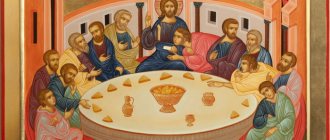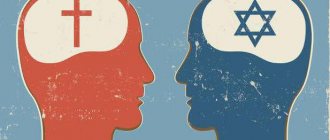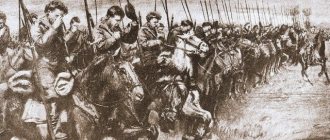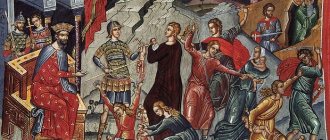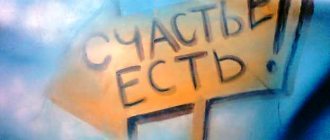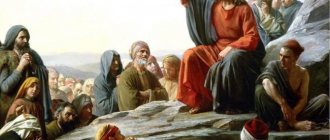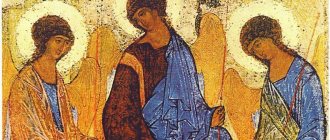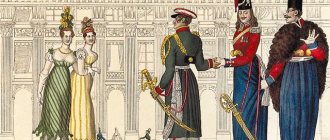Did the ancient Jews have painting?
In the Jewish tradition there was a ban on images of God. However, by the will of God, the Tabernacle, and then the Temple of Solomon, were decorated with a number of sacred images. Thus, on the covers and veil of the Tabernacle, cherubim of skillful work were depicted by specially chosen craftsmen (Ex. 26: 1–31). The Old Testament also speaks of decorating walls with picturesque images (Ezek. 23:14–15), which some representatives of Israel sympathized with, houses (2 Mac. 2:30), and pagan idols (Wis. 15:4), while the latter are called “ a crafty human invention”, “the fruitless labor of artists”.
Orthodoxy and fine arts
Content
- Introduction
- 1. Images of the salvation not made by hands and their embodiment in fine art
- 2. The image of the Mother of God and her spiritual origin in painting
- 3. Features of festive images in fine arts
- 4. Images of angels, archangels, seraphim and cherubs
- 5. Saints, prophets, forefathers and martyrs in the visual arts
- Conclusion
- Literature
Introduction
Old Russian painting, all its images are inextricably linked with the church, with the temple building itself. This connection is extremely deep; painting not only decorates an Orthodox church, but forms a harmonious semantic and artistic unity with it. The fact is that the church building itself was interpreted as an image of a different Church. The spiritual Church, as an image of the unity of all believers in the name of salvation, headed by Jesus Christ. And in order for this meaning of the temple, the spiritual, symbolic meaning of the church building itself to appear as clearly as possible, even in Byzantium a harmonious system of arranging picturesque images on its walls was developed. Ancient Rus' adopted this system in its main features, and although ancient Russian art created unsurpassed frescoes and mosaics, most of it consists of icons-images painted on one board. Therefore, the topic of the work is relevant
and practically significant.
An object
research - Orthodoxy.
Item
research - Orthodoxy and fine arts.
Target
research - determining the place of Orthodoxy in the fine arts.
On the way to the goal, the following tasks
: give a definition of the Savior and his images in the fine arts; consider the image of the Mother of God and her spiritual origin in painting; identify the features of festive images in the fine arts; study images of angels, archangels, seraphim, cherubim, saints, prophets, forefathers and martyrs in fine art.
Methods
research: study of the theory of the issue; analysis of literary sources; observation; analysis of the results obtained.
The test was based on the works of: N.A. Barskoy, F.M. Atsamba, G. Ostrovsky and others.
1. Images of the salvation not made by hands and their embodiment in fine art
The main, central image of all ancient Russian art is the image of Jesus Christ, the Savior, as he was called in Rus'. Savior (Savior) - this word absolutely accurately expresses the idea of the Christian religion about him. It teaches that Jesus Christ is a Man and at the same time God and the Son of God, who brought salvation to the human race. The basis of these ideas is the Gospel. (The word “gospel” itself means “good news.”) The four books that make it up, written by the apostles, disciples of Jesus Christ, carry the “good news” about the very person of the Savior, about the salvation he brought to the world. History of religion in 2 vols. . 2 [Text] / F.M. Atsamba, N.N. Bektimirova, I.P. Davydov and others; Under general ed. prof. I.N. Yablokov. — Ed. 2nd, rev. and additional — M.: “Higher. school", 2004. - P. 34. .
Any image of Jesus Christ in ancient Russian art was also called Savior - and this was not a simple transfer of the name of the person depicted onto it. Jesus Christ appears as the Savior of the world on frescoes and icons, in mosaics and miniatures, i.e. the deeply understood essence of the Gospel tradition lies at the basis of its images, created at all times of the existence of ancient Russian art.
In order to get closer to understanding this essence, and thereby to the real perception of these images, it is necessary to present the Gospel story at least to some extent fully. It is very short, but surprisingly capacious and in many ways mysterious, the meaning contained in it emerges gradually, appears in a natural combination of episodes, details, details. The ancient and profound interpretation of the Gospel, which Rus' inherited from Byzantium, understood the story about Jesus Christ contained in it as a story about the great, incomprehensible God, “incarnate” in the name of people. Having united with his divine nature the fullness of human nature, he brings his “testament” to people, his preaching and, having experienced the suffering, humiliation, and death inherent in this nature, atones for human sins. Both in Byzantium and in Ancient Rus', great importance was attached, therefore, to the image of Jesus Christ: the very opportunity to depict him, to present him “according to the flesh” was a confirmation of this joyful incarnation that had taken place for the sake of people.
But in order to be genuine evidence of this incarnation, in order to create the image of the Jesus Christ who appears in the Gospel, these images had to meet two requirements, which they always met in the art of Byzantium and Ancient Rus': to convey with all possible accuracy the real appearance of the man Jesus , about whose earthly life the gospel story narrates, and at the same time reveal in his appearance that mysterious, divine principle, the presence of which this story also constantly points out Christianity: Encyclopedic Dictionary. In 3 volumes. T. 3 [Text]. - M.: Higher. school, 1995. - P. 534. .
The Gospel itself does not contain any information about the appearance of Jesus Christ. Tradition believes that the source of ideas about her were his lifetime images. Indeed, there is historical evidence that in the first centuries of the new era in Palestine and Syria there were images that were revered as lifetime portraits of Jesus Christ.
It is therefore quite likely that the image of the Savior that we invariably see in ancient Russian art goes back to these images that have not reached us: the characteristic appearance of a mature husband with long hair and a small beard, who is always unmistakably recognized by people. Jesus Christ is endowed with such features already on reliefs and frescoes of the 4th century; As historically reliable, they were carefully preserved by the art of the entire Byzantine world; they were inherited and preserved by the painting of Ancient Rus'.
Those obligatory signs that denote the high, mysterious and divine essence of the Savior in this painting also go back to Byzantine antiquity. Traditionally, on any image of him, the letters IC XC are located on both sides of the head - the word designation of his personality, an abbreviation of his name - Jesus Christ ("Christ" in Greek - the anointed one, the messenger of God). Also traditionally, the head of the Savior is surrounded by a halo - a circle, most often golden - a symbolic image of the light emanating from it, the eternal light, which is why it takes on a round, beginningless shape. This halo, in memory of the sacrifice on the cross he made for people, is always lined with a cross, and at its crosshairs are the Greek letters COON, meaning “eternally existing,” affirming the eternal existence of the one who made this sacrifice.
And then, in ancient times, in Byzantine art, purely artistic, pictorial techniques developed that made it possible to reveal the spiritualizing, divine principle in the very features, in the very real appearance of Jesus Christ, to imagine his human flesh “transformed” by this principle. These techniques were developed throughout its history by Byzantine art itself, and they were also remarkably developed by the artists of Ancient Rus'. This made it possible to reveal different facets of his personality in the images of the Savior, to create an almost infinite variety of these images.
The Image Not Made by Hands, or otherwise the Savior Not Made by Hands, is the most important model that was followed by masters at all times as long as ancient Russian art existed, an icon created, according to legend, not only during the lifetime, but also by the will of Jesus Christ himself. The legend of the Image Not Made by Hands asserted not only that this image was created by the will of Jesus Christ himself, but also that it was created by him to help a suffering person. And these properties of help and protection were associated in Rus' not only with that image, which was revered as a genuine Image Not Made by Hands, but also with its repetitions, which is why the “Savior Not Made by Hands” was often placed in Rus' above the gates of fortresses, on military banners.
Thus, separate types, or “versions” (as they said in Rus'), of images of the Savior, connected by common features and a common meaning, emerged, which included works created at different times and by different artists.
2. The image of the Mother of God and her spiritual origin in painting
Next to the images of the Savior in ancient Russian art, in their meaning and significance, in the place they occupy in the consciousness and spiritual life of people, stand the images of the Mother of God - the Virgin Mary, from whom the Savior became incarnate, became man - the images of his earthly Mother.
Following tradition, the Mother of God is called “the firstfruits of salvation” in church hymns glorifying her. An inhabitant of the Earth, she gave flesh to God who became human for the sake of people. In her, the goal for which this incarnation took place was the first to be achieved: in her, the Mother of the Savior, who became the “container of the inconceivable God,” who most fully approached her great Son, human nature was free, cleansed from sin and distortion. Just as it was purified in Christ himself, just as it should be purified, according to Christian doctrine, in the end, for all who followed the Savior of the human race. Fundamentals of Religious Studies: textbook [Text] / Yu.F. Borunkov, I.N. Yablokov, K.I. Nikonov and others; Ed. I.N. Yablokov. 4th ed., revised. and additional - M.: Higher. school, 2004. - P. 121. .
And Christians have a firm belief that, having become the Lady of the world, the Mother of God became the unchanging intercessor of people: her eternal maternal compassion acquired its highest fullness, her heart, “pierced” by the great torments of the Son, forever responded to countless human sufferings.
The Gospel mentions the Mother of God sparingly. But since ancient times, the first Christians collected and preserved legends about it - the apocrypha that existed in Palestine. Tradition said that the first icons of the Mother of God were created during her lifetime, that they were written by one of the apostles, the author of the Gospel, Luke. All existing images of the Mother of God were erected to these icons in Byzantium and Rus'. Modern science cannot completely confirm or refute this legend: simply not a single image of the Mother of God has reached our time that could be dated to the 1st century of the new era - the supposed time of life of her and the Evangelist Luke. But her images of the 2nd-3rd centuries have reached us, and it is likely that many of their stable features, which art subsequently preserved, go back to even earlier, perhaps even lifetime, icons.
Some of the oldest Russian icons were directly attributed to the Apostle Luke. According to existing historical evidence, all of them - both those that have survived to our time and those that have not survived to this day - were written much later than the 1st century. And although in a number of cases they could not help but know in Rus' that these works could not have been written by the Apostle Luke himself, there was neither a lie nor a contradiction in the fact that they were attributed to the Apostle Luke: authorship here was understood not only literally, but also our sense of the word, but it could indicate that these icons attributed to Luke are extremely accurate lists (repetitions) of works revered as his own creation.
Among the works of the evangelist artist was also the icon “Our Lady of Vladimir”, which was considered a palladium, the patroness of Russia, now in the collection of the Tretyakov Gallery World of Russian Culture. Encyclopedic reference book [Text]. - M.: Veche, 2000. - P. 324. .
There is chronicle news that this icon was brought to Kyiv from Constantinople at the beginning of the 12th century (as the capital of Byzantium, Constantinople, was called in Rus'). She received the name “Vladimirskaya” in Rus': Prince Andrei Bogolyubsky took her with him from Kyiv, going to the northeastern lands. And here, in the city of Vladimir, the icon found its glory.
fine arts orthodoxy saved
Thus, the image of the Mother of God is second in importance after the image of Jesus Christ in the Bible and fine arts.
3. Features of festive images in fine arts
At the center of ancient Russian painting is the image of Jesus Christ, the image of God, who became incarnate for the sake of human salvation, and the image of his earthly Mother, the Virgin Mary, the Mother of God, who gave him flesh for this incarnation, making possible his life lived in the name of people. Therefore, images of events from the life of Jesus Christ and the Mother of God, understood as milestones on the path of human salvation, occupy a very important place here. Just as milestones on the path of human salvation were understood as the events from the life of the apostles, from which the spread of the “good news” in the world about the incarnate God and the teaching he brought, and the events associated with the establishment of this teaching in the world began, they were also very often depicted in ancient Russian art. Picturesque images of all these events were usually called holidays.
The fact is that even in ancient times, solemn holidays were established in honor of most of them and repeated from year to year. On the day when, according to legend, any of these events occurred, a service was performed (and is being performed) in churches, where this event is interpreted and glorified, where its irrevocable meaning for people, for human salvation, is revealed. The image was supposed to help and did help in this comprehension. Old Russian art inherited from Byzantium and developed methods and techniques that made it possible to present a sacred event in strict accordance with tradition, as close as possible to historical authenticity and at the same time, free from everyday trifles - the way it should live in the eternal memory of people, the way it appears on a church holiday.
There are twelve main, main church holidays in the year (that’s why they are called the twelve). These include four holidays in honor of events in the life of the Virgin Mary: the Nativity of the Virgin Mary, the Entry of the Virgin Mary into the temple. Annunciation, Dormition; six - in honor of the events of the earthly life of Jesus Christ: Nativity of Christ, Presentation, Baptism (Epiphany), Entry into Jerusalem, a holiday in honor of the acquisition of the grace of the Holy Spirit by the apostles - disciples of Jesus Christ, the Descent of the Holy Spirit on the apostles and a holiday in honor of the establishment of Christianity in the world — The erection of the honest and life-giving Cross. Besides the Twelve, the most important holiday - the holiday of feasts - is Easter, the Resurrection of Christ. Therefore, the main place among the picturesque images of holidays is occupied by images of those events that are celebrated on the twelve holidays and Easter.
But quite numerous in ancient Russian painting are images of some events, the celebration of which is not included in the twelve: images of the Raising of Lazarus - the last miracle performed by Jesus Christ before his death, which is celebrated on the eve of the Entry into Jerusalem, on the so-called “Lazarus Saturday”; images of the Myrrh-Bearing Women at the tomb. Assurances of Thomas - events confirming the great and joyful mystery of the Resurrection of Jesus Christ, which are remembered in the first two weeks after Easter.
But there are no church holidays in the literal sense of the word in honor of very important events in the life of Christ: in honor of his suffering and death, at the price of which human salvation was purchased, in honor of his torment, which is called “The Passion of the Lord.” Indeed, torment, suffering, death are difficult, and, as it seems, simply impossible to connect with the word “holiday”. The Church remembers the suffering and death of Christ during the services of the special Holy Week preceding Easter, which coincides in time with the most severe, Great Lent. But the passions of Christ are called “saving” in the services dedicated to them. And remembering the fullness of the suffering experienced by the Savior, the entire abyss of grief that accompanied his torment and death on the cross, in the services of Holy Week the deep, bright saving meaning of the Passion of Christ is steadily revealed.
The Passion of Christ, together with the holidays, are included in a single circle of annual services, which, overcoming time, makes us accomplices of great events that served the cause of human salvation.
Since ancient times, the Passion of Christ has been depicted in ancient Russian painting; very early images of them in church paintings have survived to this day. And just as in the services of Holy Week, the artists initially sought to convey the torment of Jesus Christ with all historical accuracy and at the same time reveal their saving, bright and joyful meaning. Fundamentals of Religious Studies: textbook [Text] / Yu.F. Borunkov, I.N. Yablokov, K.I. Nikonov and others; Ed. I.N. Yablokov. 4th ed., revised. and additional - M.: Higher. school, 2004. - P. 239. .
Thus, holiday icons reflect all the events of the life, martyrdom and resurrection of Jesus Christ.
4. Images of angels, archangels, seraphim and cherubs
The Holy Scriptures, both the Old and the New Testaments, affirm the existence of certain ethereal forces serving God. These disembodied forces, fulfilling the will of God, participate in human life. Ancient theology, based on the texts of the Old and New Testaments, believed that these forces differ in their closeness to God, and on the basis of this they are divided into separate ranks. It numbered nine ranks of these disembodied forces and called them “nine ranks of angels.” It was believed that three ranks were closest to God - seraphim, cherubim, thrones (not to be confused with the word “throne”, used in the sense of “throne”, as well as “throne” - a table in the altar for performing the sacrament). These ranks are followed by three other ranks - dominion, strength and power. The last three ranks of the nine are marked by closeness to the world and man. These are the beginnings, archangels and angels (angels in the proper sense of the word). Those attracting “the likeness of man” were understood as “ranks of angels”: fiery and winged ones - cherubs, moving wheels - thrones, and wheels with rims strewn with eyes - the powers of Christianity: Encyclopedic Dictionary. In 3 volumes. Decree. ed.S. 278. .
Both Byzantine and Old Russian painting relied on the sacred texts about the visions of the prophet Isaiah and the prophet Ezekiel. From them all the information about the appearance of the “nine angelic ranks” and their service to God was gleaned. Based on these biblical texts, ancient Russian painting depicted seraphim with six wings, and cherubs with wings and fire. The images of both of them, chanting and guarding God, were placed by ancient Russian masters in the temple under the drum, under the image of the Almighty. They sometimes painted disembodied guardians, seraphim and cherubim, on icons of the Mother of God, whom hymns glorify as “the most honorable cherub and the most glorious seraphim without comparison.” The fiery cherub, guarding the tree of life, was given a place, as a rule, in images of paradise.
Images of thrones in the form of winged rings and powers in the form of rings with eyes were usually included in the compositions “The Savior is in Power.” Old Russian icon painters did not depict the other highest of the “nine ranks of angels,” since the Bible contains neither descriptions nor information about their connection to the world.
But most often in the art of Ancient Rus' one can find images of angels themselves, who are closest to man from all the disembodied forces and belong to the last three angelic ranks - the principles, archangels and angels.
Angels participate in many gospel events: they are present at the Nativity of Christ, bring the news of his Resurrection, and participate in the Ascension. And in the compositions depicting these events, angels appear in the form that, based on the texts of Scripture, the art of Byzantium gave them - in the form of beautiful creatures, similar in appearance to people, but endowed with wings. Individual images of angels are rare in ancient Russian art; more often they depicted the supreme angels - the archangels Gabriel and Michael.
Archangel Gabriel is a bright, obedient messenger to God. He brings the news to the Mother of God in the Annunciation and the Assumption, he also brings the news about the birth of the future John the Baptist from Elizabeth and Zechariah.
One of the most famous images of the Archangel Gabriel is the icon, also called the “Golden Hair Angel,” painted in Novgorod in the 12th century. The icon was once part of the main Deesis tier, where everyone is depicted “mainly”, up to their necks, and only the head of the Archangel Gabriel is represented on it. A special attribute speaks about the angelic nature of the person depicted here: on the right is a “hearing” - a “torque”, with the help of which the angels hear God.
Thus, the painting reflects the images of the last three ranks, those in the service of God and those closest to people.
5. Saints, prophets, forefathers and martyrs in the visual arts
In ancient Russian art there is a very wide range of images representing saints. According to Christian doctrine, saints are people of high righteousness who glorified themselves by serving God. With this righteousness they “acquired grace”: their human nature, darkened by sin, but initially created in the image and likeness of God, was purified and transformed, and they found eternal life. It was believed that the saints had already embodied the plan of Jesus Christ for man: for the sake of atonement for human sins, he sacrificed himself. As theologians interpreted it, “God became man so that man could become God” Barskaya, N.A. Subjects and images of ancient Russian painting [Text] / N.A. Barskaya. - M.: Education, 1993. - P. 123. .
It was believed that the Old Testament already tells about such people, about saints. Following the story of the creation of the world and the fall of Adam and Eve, it talks about the beginning of the restoration of the connection between man and God, about the people who served this restoration with their righteousness. These people were considered saints in Christianity.
The New Testament, which talks about the incarnation of God for the sake of people, about bringing them a saving creed, also speaks of many people who have truly approached God. As Christianity spread throughout the world, many people became famous for their righteousness, were considered to have acquired grace, and were canonized.
The martyrs who died for their faith during the persecution of Christians were revered as saints; the hierarchs of the church who approved its doctrine; monks who renounced worldly temptations for the sake of serving God. Along with the saints inherited by Ancient Russia with the adoption of Christianity, it also had its own righteous people. In their newfound height, saints are the connectors between God and people, their intercessors and intercessors before him.
About those of them who became famous for righteousness after the spread of Christianity, information was carefully collected (sometimes this began to be done even during the life of the righteous person), and when the glorified person was canonized after death, he was canonized, on the basis of this information a life was compiled that helped understand what his righteousness consisted of. And, helping this understanding, the saints were necessarily remembered and glorified at church services.
His images—icons—were supposed to serve this same goal of comprehension, of approaching the saint in whom he trusted, to whom he turned in prayer. Striving towards this goal, to express the truth about the person depicted, the features of his appearance, once gleaned from lifetime images or from ancient verbal descriptions, were carefully preserved over the centuries - the icon of the saint embodied a living, concrete human personality. But, reaching the true depth of this truth, icon painters never stopped at this portrait resemblance, although it was mandatory for them. Using the means of painting itself, they showed this living human personality, real human nature, transformed, enlightened by great freedom from sin. Icons of the saint made visible, preserved in human memory what the word conveyed about the saint: the text of the Bible, the text of the Gospel, lives written in honor of the holy hymn of the service.
There were a great many saints revered in Rus'. But among this multitude there were those especially beloved and revered by the people - among them those about whom the Old and New Testaments spoke, and those who became famous after the spread of Christianity, and those who “shone in the Russian land.” Those saints in whose intercession the people especially strongly trusted were depicted more often than others. The most prominent place is occupied by their images in ancient Russian painting, making up its bright, unique page.
Forefathers, biblical patriarchs - this is the name given to the ancestors of all humanity and the people of Israel described in the Old Testament, from the time of Adam to the time Moses received the Law from God. The forefathers began with their righteousness the restoration of the connection between man and God, broken by the fall of Adam and Eve. They sought to comprehend God, and with one of them, with Abraham, God made his first Covenant with man.
Christianity honors its forefathers for this, and honors in them the ancestors of Jesus Christ according to the flesh. In addition, interpreting the Old Testament as a prototype of the New Testament, he sees in the very comprehension of God by the Old Testament forefathers premonitions and predictions of the Savior. Therefore, the forefathers were recognized as saints. The forefathers were depicted much less often than the New Testament saints, than those who lived and acted after the coming of Jesus Christ into the world, nevertheless, ancient Russian art created their beautiful, very significant images.
Prophets - in the literal sense of the word - are those who are given the gift of prophecy, divinely illuminated heralds of the future. These are the saints about whom the Old Testament tells. The prophets are narrated in the Bible where the history of the Israeli people is told after they received the tablets of the Covenant from God, after God gave them the Law by which they should live. And the prophets, filled with divine inspiration, denounce the people and rulers when they deviate from the Law, prophesy the fate of apostates, and prophesy the future destinies of the world and the accomplishments of God in it. Christianity honored in the prophets their comprehension of the one God, as he was revealed to people in the Old Testament, the fidelity to this God in which they acquired grace and acquired the prophetic gift. And just as Christianity understands the entire Old Testament as a preparation for the New Testament, so the prophecies of the prophets are interpreted as predictions about the incarnation of God, about the coming of the Messiah Jesus Christ.
Of all the persons of the Old Testament, the prophets were most often depicted in ancient Russian art. The strength of personality that they showed, defending faith in the true God, the depth of their prophecies, in which they saw not only the predictions of Jesus Christ, but also the Virgin Mary, attracted artists and inspired them to create vivid and very diverse images. The Old Testament prophet Elijah was deeply revered in Rus' and was very often depicted in ancient Russian art.
John the Baptist - the Forerunner of Jesus Christ and his Baptist - the greatest Christian saint. Information about John the Baptist goes back to the Gospel. All four evangelists talk about him. In addition, some details about the life of John. The Forerunners contain apocrypha, including such as the Proto-Gospel and the Gospel of Nicodemus.
Christians called John “the end of the prophets,” since he not only predicted the appearance of Jesus Christ, but also saw this prophecy come true, saw Jesus Christ appear in the flesh. For this prophecy, for the fact that, according to his preaching, John is the predecessor, the Forerunner of Jesus Christ, Christianity highly honors him. Church hymns glorify him, emphasizing his prophetic gift, voluntary hermitage, and his martyrdom for the truth.
John the Baptist began to be depicted in the art of the first Christians, first in the “Baptism” scene, and then alone. From there the art of Byzantium, and then Ancient Rus', drew the characteristic features of John, the always recognizable features of a long-haired mature man. His clothes made of camel hair also became almost obligatory.
Among the images of saints in ancient Russian art, images of the apostles Peter and Paul occupy an important place. Apostles (“apostle” in Greek - sent) are the disciples of Jesus Christ sent by him to preach his teaching and who became the founders of the Christian church. All the apostles, all the disciples of Jesus Christ are deeply revered by the Christian world, but Peter and Paul are recognized as the main ones, the supreme apostles.
Thus, people sought to get closer to the saints, to comprehend them, to convey their prayer to them. For this purpose, the memory of the saints was carefully preserved: everything that was said about them in the Old and New Testaments, in the ancient stories and apocrypha that supplemented this was comprehended.
Conclusion
The main, central image of all ancient Russian art is the image of Jesus Christ, the Savior, as he was called in Rus'. Savior (Savior) - this word absolutely accurately expresses the idea of the Christian religion about him. Any image of Jesus Christ in ancient Russian art was also called Savior. Jesus Christ appears as the Savior of the world on frescoes and icons, in mosaics and miniatures.
Next to the images of the Savior in ancient Russian art, in their meaning and significance, in the place they occupy in the consciousness and spiritual life of people, stand the images of the Mother of God - the Virgin Mary, from whom the Savior became incarnate, became man - the images of his earthly Mother. Tradition said that the first icons of the Mother of God were created during her lifetime, that they were written by one of the apostles, the author of the Gospel, Luke.
The Holy Scriptures, both the Old and the New Testaments, affirm the existence of certain ethereal forces serving God. These disembodied forces, fulfilling the will of God, participate in human life. It was believed that three ranks were closest to God - seraphim, cherubim, thrones. These ranks are followed by three other ranks - dominion, strength and power. The last three ranks of the nine are marked by closeness to the world and man. More often in the art of Ancient Rus' you can find images of angels themselves, who are closest to man and belong to the last three angelic ranks - the principles, archangels and angels.
In ancient Russian art there is a very wide range of images representing saints. According to Christian doctrine, saints are people of high righteousness who glorified themselves by serving God.
Thus, Orthodox fine art fully reflects people’s ideas about God, his environment and reflects all the plots of the Gospel.
Literature
1. Barskaya, N.A. Subjects and images of ancient Russian painting [Text] / N.A. Barskaya. - M.: Education, 1993. - 223 p.
2. History of religion in 2 volumes. T.2 [Text] / F.M. Atsamba, N.N. Bektimirova, I.P. Davydov and others; Under general ed. prof. I.N. Yablokov. — Edition 2, rev. and additional — M.: “Higher. school", 2004. - 676 p.
3. The world of Russian culture. Encyclopedic reference book [Text]. - M.: Veche, 2000. - 624 p.
4. Fundamentals of religious studies: textbook [Text] / Yu.F. Borunkov, I.N. Yablokov, K.I. Nikonov and others; Ed. I.N. Yablokov. 4th ed., revised. and additional - M.: Higher. school, 2004. - 511 p.
5. Ostrovsky, G. A story about Russian painting [Text] / G. Ostrovsky. - M.: Fine Arts, 1987. - 360 pp.: ill.
6. Christianity: Encyclopedic Dictionary. In 3 volumes. T.3 [Text]. - M.: Higher. school, 1995. - 676 p.
What are the origins of Christian painting?
The origins of Christian painting should be sought not in the Jewish, but in the Greco-Roman and Egyptian traditions, where fine and plastic arts were widely developed. To some extent, the Christian icon is the successor to the ancient funeral image, which is confirmed by a comparative analysis of early Christian icons and the so-called. Fayum portraits - Egyptian funerary images found by archaeologists in Fayum and other cities of Egypt.
Orthodox art
As the most inexorable judge - time - shows, the separation of the Orthodox Church and the state did not benefit the latter. In former times, Christian ideology filled all levels and spheres of human life, all social institutions. Needless to say, religious institutions were under the protection of the state, and the consciousness of society and spiritual culture were interconnected, if not homogeneous, phenomena. How can we find Orthodoxy in art?
The ruling class encouraged spiritual influence on society. Thus, Orthodoxy was reflected in religious architecture, sculpture, stained glass art, jewelry... At the same time, folk art was to a certain extent free from Christian influence, and even more inclined to forgotten pagan traditions, freedom-loving ideas bordering on atheism. Such manifestations could be observed in the art of traveling theaters, buffoonery, in the works of secular authors of the Middle Ages, such as “The Tale of Igor’s Campaign,” epics, and various folklore genres.
However, neither folk nor secular art could compete with Christian art, imbued with a clear ideology, having a certain established canon, plot, and, most importantly, filled with spirituality. The religious canon, in general, is a set of principles of the Christian worldview, as well as certain methods of tasks and norms that were set for artistic and figurative creativity. The Orthodox Church has developed and approved a single canon, on which Orthodox art is based even today - as an example or template for imitation by all who strive in the field of artistic art, which is a kind of ideal of holiness, and the most acceptable reflection of the divine.
For example, the Orthodox canon of painting was established so that the faces of saints, deities and martyrs on all icons and frescoes were the same. Examples of this canonical approach today are the icons of Novgorod and Pskov, as well as frescoes dating back to the 13th-14th centuries. Rus' borrowed such a religious and artistic canon from Byzantium, from where, in fact, Christianity came to us. The Orthodox iconographic canon, representing Orthodox culture, demands that in the image of the Lord Christ, as well as in the faces of the entire pantheon of Orthodox saints and great martyrs, there should be divinity and detachment from earthly deeds, a certain ethereality, holiness.
Orthodox icons, painted according to the canon, are quite motionless, definitely static, flat. These qualities reflect the unchanging Eternal. It is noteworthy that on Orthodox icons space is always depicted rather conditionally: several projections are combined using reverse perspective. Orthodox icons are enriched with golden radiance and golden halos. Orthodox icons are especially famous for this artistic technique. The golden glow is intended to transport the viewer not just to the past, to the moment when this depicted scene took place, but to another, spiritual dimension, representing its essence.
Comments on the article
Add a comment
July 24, 2021
Can the wall paintings in the Roman catacombs be called icons?
These images, dating from the 2nd to 6th centuries, can be called the forerunners of icons, but not icons in the modern sense of the word. Meanwhile, since an icon, in the literal meaning of the word, is interpreted as an image, and these images represent either images of holy persons or images of events significant for the Church, they can be called icons, conditionally. All catacomb images can be divided into several categories: 1) symbols and symbolic images; 2) semi-symbolic images; 3) images inspired by ancient images, reinterpreted in the Christian spirit; 4) paintings on Christian subjects. All these images are of a moral and didactic nature and are intended to reflect the basic truths of Christian doctrine. Most of the images are made using the fresco technique, but there are also mosaics.
Art in OrthodoxyOf course, art and Orthodoxy cannot exist separately, since both one and the other are directly related to the most subtle facets of the human soul. Architecture, painting, music, literature and many other types of art have found their place in Orthodoxy. Over the course of many centuries, art and the Orthodox faith intertwined and flowed into each other, as a result of which Orthodox art arose. Perhaps the most striking and fundamental in Orthodox art are architecture and painting. Orthodox churches are not only shrines for millions of people, but also priceless monuments of world architectural art. Today there are about 25 thousand churches in Russia alone. Among them are the world-famous Cathedral of Christ the Savior, the largest in the Russian Church, the unique monastery complex - the Kiev Pechersk Lavra and many others. It is in them that not only the history of Rus' lives, but the history of the Orthodox faith and art in general. Fine art occupies an equally important place in Orthodox art. Icon painting is the creation of images, the purpose of which is to be a connecting link between the earthly world and the Divine. According to Prince E. Trubetskoy, an icon is “a reflection in colors.” Andrei Rublev is considered the greatest Russian icon painter. In our time, icons are created by such creators as L. Vinnitskaya, V. Morozov, L. Zavgorodnyaya and many others. Also, other forms of fine art are separated from icon painting, such as monumental painting (frescoes), decorative and applied arts, and others. On the other hand, there is painting of Orthodox content, which simply uses biblical subjects in the author's interpretation. With the development of modern art, cinema slowly began to enter Orthodoxy. In addition to documentaries, feature films have recently begun to be produced, which can rightfully be considered Orthodox. An example of this is the painting “Island” by Pavel Lungin. So, art and Orthodoxy are closely related and intertwined. And, most importantly, they are united in their main goal - to unite and educate people, touching the most subtle strings of human souls.
2010-03-29 16:58:13
| Articles. New in this section. |
